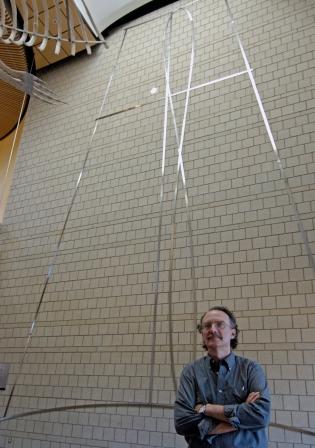
James Evans
Director, Program in Science, Technology and Society,
and Professor of Physics, University of Puget Sound.
Associate Editor,
Journal for the History of Astronomy.
Department of Physics
Phone: (253) 879-3813
University of Puget Sound Fax: (253) 879-1572
1500 North Warner St.
Tacoma, WA 98416 USA
e-mail: jcevans@ups.edu

Sundial and analemma in Harned Hall, University of
Puget Sound, designed and installed in 2006. A
mirror
under a skylight reflects a spot of sunlight
onto the
sundial and analemma.
Details of sundial and analemma
Equinox slide show
(Spring equinox of March 20, 2007,
photographed by Bernard Bates)
Teaching Interests
Courses taught in the last few years include:
PHYS 299 The History and Practice of Ancient Astronomy
STS 166 Science and Theater
STS 201 Introduction to Science, Technology and Society I
(Antiquity to 1800)
STS 202 Introduction to Science, Technology and Society II (19th
and 20th Centuries)
STS 314 Cosmological Thought
STS 348 Strange
Realities: Physics in the Twentieth Century
STS 490 Senior Seminar in STS
HON 212 Origins of the Modern Worldview
PHYS 494 Special Topics in Theoretical Physics: Variational
Principles in Physics
Research Interests
In history of science: ancient Greek astronomy, science in the
Enlightenment,
history of physics from the 18th through the 20th centuries,
history of cosmology from antiquity to the present
In physics proper: the action principle, optical-mechanical analogies
Books
James Evans, The History and
Practice of Ancient Astronomy
(New York: Oxford University Press, 1998) errata
James Evans and Alan S. Thorndike, eds., Quantum Mechanics at the
Crossroads:
New Perspectives from History, Philosophy and Physics
(Heidelberg: Springer, 2006)
James Evans and J. Lennart Berggren, Geminos's Introduction to the
Phenomena:
A Translation and Study of a Hellenistic Survey of Astronomy
(Princeton: Princeton University Press, 2006) errata
Selected Articles: History of Science (by James Evans unless co-authors are listed)
“Fonction et origine probable du point équant de Ptolémée.” Revue d'histoire des sciences et de leurs applications 37 (1984) 193-213.
“On the function and the probable origin of Ptolemy’s equant.” American Journal of Physics 52 (1984) 1080-1089. pdf
James Evans and Brian Popp, “Pictet’s experiment: The apparent radiation and reflection of cold.” American Journal of Physics 53 (1985) 737-753. pdf
“On the Origin of the Ptolemaic Star Catalogue: Part 1.” Journal for the History of Astronomy 18 (1987) 155-172 and “… Part 2,” Journal for the History of Astronomy 18 (1987) 233-278.
“The division of the Martian eccentricity from Hipparchos to Kepler: A history of the approximations to Kepler motion.” American Journal of Physics 56 (1988) 1009-1024. pdf
Articles on ancient Greek astronomy in Encyclopedia of Cosmology, Norriss Hetherington, ed. (New York: Garland Publishing, 1993): “Ptolemaic Planetary Theory,” p. 513-526. “Ptolemy,” p. 526-528. “Ptolemy’s Cosmology,” p. 528-544. “Theon of Smyrna,” p. 642-643.
“A Cosmogenesis: The Origins of Ptolemy’s Universe.” Histoire et actualité de la cosmologie, Vol. I, François De Gandt and Christiane Vilain, eds. (Paris: Observatoire de Paris, 1996), p. 21-39.
“Fraud and Illusion in the Anti-Newtonian Rear Guard: The Coultaud-Mercier Affair and Bertier’s Experiments, 1767-1777.” Isis 87 (1996) 74-107. pdf
“The Material Culture of Greek Astronomy.” Journal for the History of Astronomy 30 (1999) 237-307. Download from NASA Astrophysics Data System.
“Concetti generali di materia e moto.” Storia della scienza, Sandro Petruccioli, ed., Vol. VI, L’Età dei lumi (Roma: Instituto della Enciclopedia Italiana, 2002), p. 29-42, 46-47.
Articles on eighteenth-century astronomy in Storia della scienza, Sandro Petruccioli, ed., Vol. VI, L’Età dei lumi (Roma: Instituto della Enciclopedia Italiana, 2002): “La vecchia guardia e la stabilità del Sistema solare,” p. 244-247. “Un nuovo Sistema solare,” p. 247-250. “Il dibattito sulle meteore,” p. 250-252. “Il movimente del Sole,” p. 252. “La nuova astronomia fisica,” p. 252-253. “Longitudine e navigazione,” p. 254-257. “La luce del Sole,” p. 258-259. “Nuove istituzioni,” p. 260-261.
“Gravity in the Century of Light: Sources, Construction and Reception of Le Sage’s Theory of Gravitation.” Pushing Gravity: New Perspectives on Le Sage’s Theory of Gravitation, Matthew Edwards, ed. (Montreal: Apeiron, 2002), p. 9-40.
“The Origins of Ptolemy’s Cosmos.” Cosmology through Time: Ancient and Modern Cosmologies in the Mediterranean Area, S. Colafrancesco and G. Giobbi, eds. (Milano: Mimesis 2003), p. 123-132.
“The Astrologer’s Apparatus: A Picture of Professional Practice in Greco-Roman Egypt.” Journal for the History of Astronomy 35 (2004) 1-44. Download from NASA ADS.
“Gnōmonikē Technē: The Dialer’s Art and Its Meanings for the Ancient World.” The New Astronomy: Opening the Electromagnetic Window and Expanding our View of Planet Earth, Wayne Orchiston, ed. (New York: Springer, 2005), p. 273-292.
"Equating the Sun: Geometry, Models, and Practical Computing in Greek Astronomy." Hands On History: A Resource for Teaching Mathematics, Amy Shell-Gellasch, ed. (Washington, D.C.: Mathematical Association of America, 2007), p. 115-123.
James Evans and Marcel Marée, “A Miniature Ivory Sundial with Equinox Indicator from Ptolemaic Tanis, Egypt." Journal for the History of Astronomy 39 (2008) 1-17. pdf
James Evans, Christian C. Carman, and Alan S. Thorndike, "Solar Anomaly and Planetary Displays in the Antikythera Mechanism," Journal for the History of Astronomy 41 (2010) 1-39. pdf
“Astronomy.” The Classical Tradition, ed. by Anthony Grafton, Glenn W. Most, and Salvatore Settis (Cambridge: Harvard University Press, 2010), p. 89-96.
Christian C. Carman, Alan S. Thorndike, and James Evans, "On the
Pin-and-Slot Device of the Antikythera Mechanism, with a New Application to the
Superior Planets" Journal for the History of Astronomy 43
(2012) 93-116.
pdf
Tracking the Cosmos: The Technology of the Antikythera
Mechanism. Video conversation between Jo Marchant, James Evans, and
Patt Morrison about the Antikythera Mechanism, at the Getty Villa in 2010.
http://www.getty.edu/museum/programs/past_programs/antikythera.html
Historical Picture Gallery
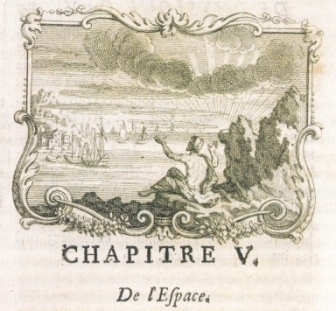

Vignettes of Space and Time in Emilie du Châtelet's
Institutions de physique (1740).
See
“Concetti
generali di materia e moto” (2002).
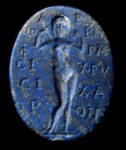
© Bibliothèque Nationale de France
(Left) Magical gem of Aphrodite that may have functioned
as a planet marker for an astrologer's board in Greek Egypt.
(Right) A coin carrying the zodiac sign of
Aries, from the Roman mint of Alexandria, year 8 of Antoninus Pius (AD 144/145).
See
“The Astrologer's Apparatus"
(2004).
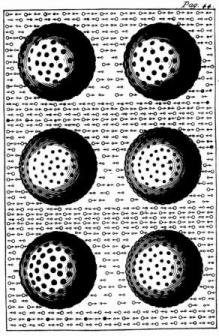
Georges-Louis Le Sage's mechanical explanation of universal gravitation, from his Essai de chymie méchanique(1758).
See “Gravity in the Century of Light" (2002).
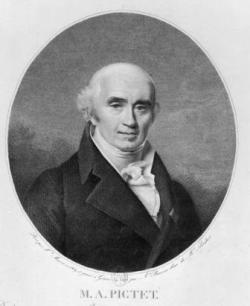
Marc-Auguste Pictet (1722-1825), the maker
of a paradoxical experiment on the radiation
and reflection of cold.
See
“Pictet's Experiment" (1985).
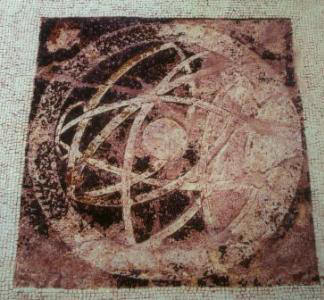
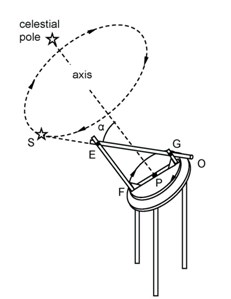 (Left) Mosaic of an armillary sphere at Solunto, near Palermo. Photo by Rudolf
Schmidt.
(Left) Mosaic of an armillary sphere at Solunto, near Palermo. Photo by Rudolf
Schmidt.
(Right) Conjectural reconstruction of Geminos's
equatorial dioptra.
See
Geminos's "Introduction to
the Phenomena" (2006).
Gothic astrolabe of French or Italian workmanship, early 15th century.
See The History and Practice of Ancient Astronomy.
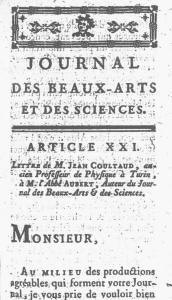
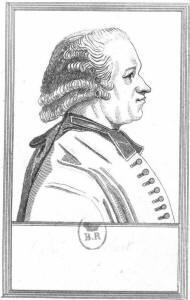
Clockwise from top left:
Letter from a mysterious Jean Coultaud, describing pendulum
experiments
performed in the mountains, refuting Newton's inverse-square law of
gravitation.
Jean-Louis Aubert (1731-1814), editor of the Journal des Beaux-Arts et des
Sciences, where
Coultaud's letter appeared in 1767.
Some hypothetical Earths, from Jean-Pierre David, Dissertation sur la figure
de la terre
(La Haye, 1771).
Church of the Oratory, rue St. Honoré, Paris, where Father Joseph-Étienne
Bertier performed
experiments showing that objects weigh more, the higher up
they are located.
See "Fraud and Illusion in the Anti-Newtonian Rear Guard" (1996).

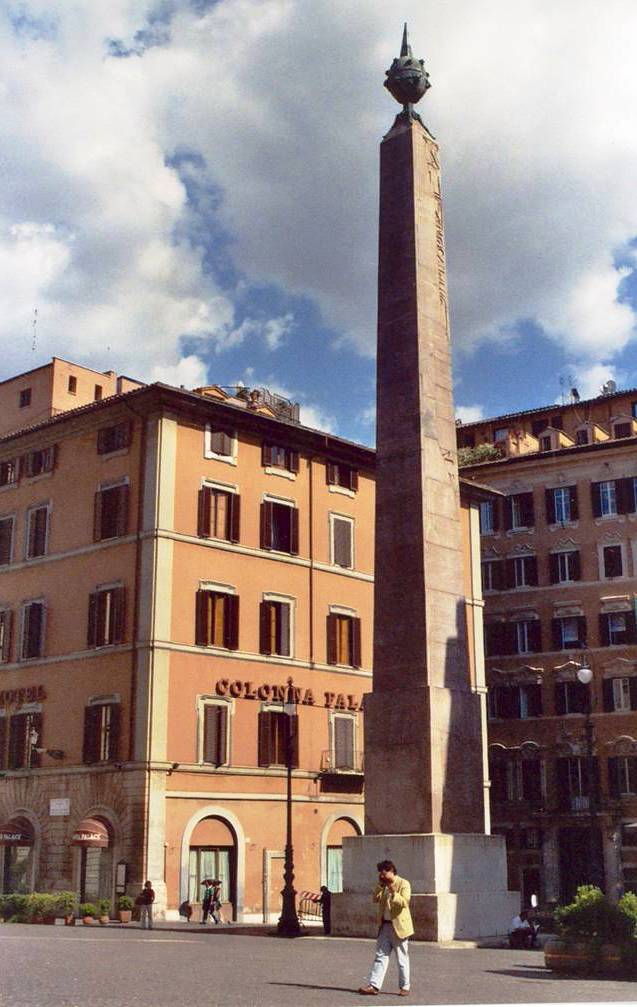
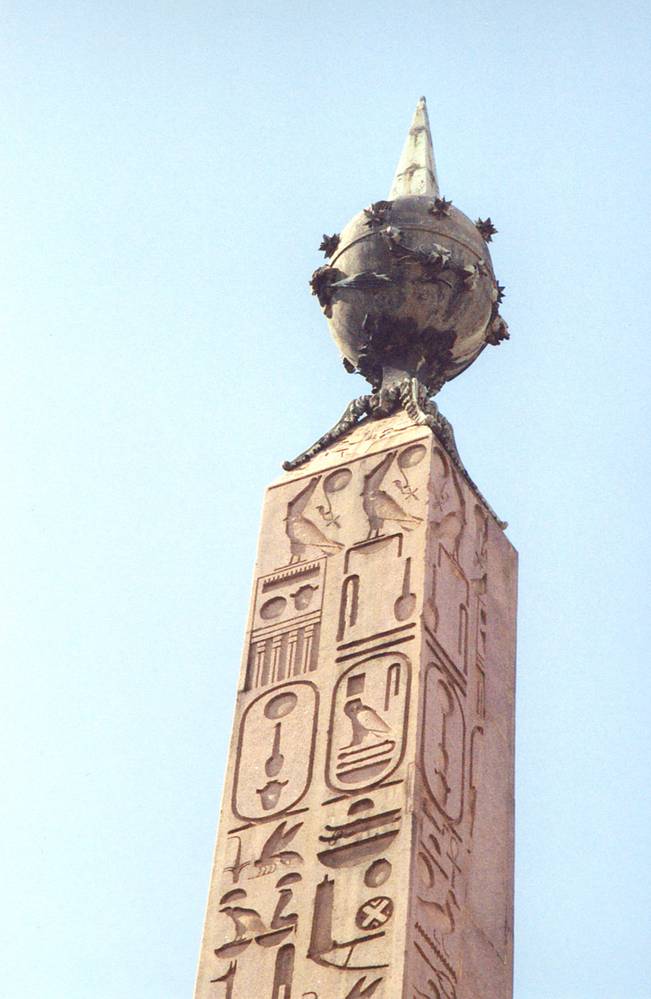 Obelisk,
taken from Heliopolis in Egypt, and used as gnomon for the monumental sundial
set up in Rome by Augustus. The obelisk is now located in the Piazza
di Montecitorio, several hundred feet south of its ancient site.
Obelisk,
taken from Heliopolis in Egypt, and used as gnomon for the monumental sundial
set up in Rome by Augustus. The obelisk is now located in the Piazza
di Montecitorio, several hundred feet south of its ancient site.
See “Gnōmonikē
Technē: The Dialer’s Art and Its Meanings for the Ancient World”
(2005).
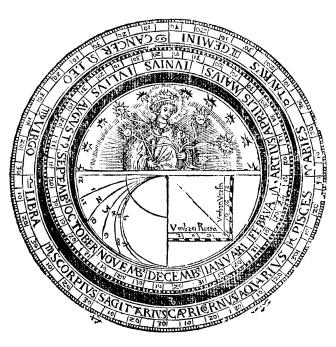
An equatorium for finding the place of the Sun in the
zodiac. The instrument is
intended to resemble the back of an astrolabe. From Cosmographia
... Petri Apiani & Gemmae Frisii (Antwerp, 1584).
See "Equating the Sun" (2007).
 (Left) The
Tower of the Winds in Athens. Each wall of this octagonal building
(constructed around 50 BC) carries a vertical, plane sundial. From James Stuart and Nicholas Revett,
The Antiquities of Athens (London, 1762). (Below) A modern copy
of the Farnese globe, one of three intact celestial globes to have survived from
antiquity.
(Left) The
Tower of the Winds in Athens. Each wall of this octagonal building
(constructed around 50 BC) carries a vertical, plane sundial. From James Stuart and Nicholas Revett,
The Antiquities of Athens (London, 1762). (Below) A modern copy
of the Farnese globe, one of three intact celestial globes to have survived from
antiquity.
See
“The Material Culture of Greek Astronomy” (1999).
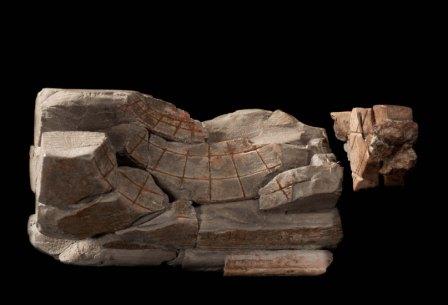
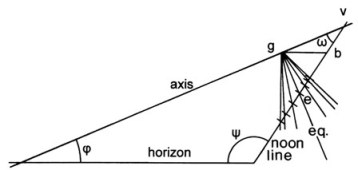
(Left) A conical Greek sundial of the first century B.C.E., found by Flinders Petrie in 1884, but only recently
restored. (Right) Analysis of the sundial.
See "A
Miniature Ivory Sundial with Equinox Indicator from Ptolemaic Tanis, Egypt"
(2008).
©
The British Museum
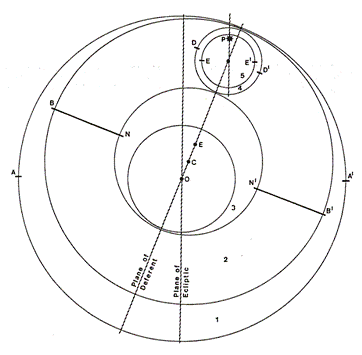
The
three-dimensional orbs for Mars, as described in Ptolemy's Planetary
Hypotheses. The earth is at O; the planet is at P.
See
“The
Origins of Ptolemy’s Cosmos” (2003).
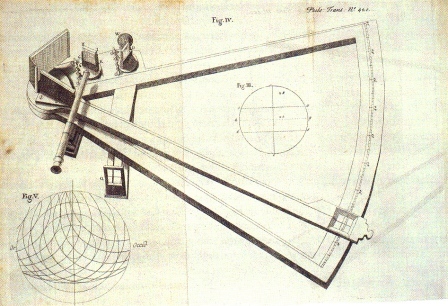
John Hadley's reflecting quadrant. From "The description of a new instrument for taking angles," Philosophical Transactions (1731).
Selected Articles: Scientific Papers
James Evans and Mark Rosenquist, “ ‘F = ma’ optics.” American Journal of Physics 54 (1986) 876-883. pdf
“Simple forms for equations of rays in gradient-index lenses.” American Journal of Physics 58 (1990) 773-778. pdf
James Evans, Kamal K. Nandi and Anwarul Islam, “The Optical-Mechanical Analogy in General Relativity: Exact Newtonian Forms for the Equations of Motion of Particles and Photons.” General Relativity and Gravitation 28 (1996) 413-439. pdf
James Evans, Kamal K. Nandi and Anwarul Islam, “The optical-mechanical analogy in general relativity: new methods for the paths of light and of the planets.” American Journal of Physics 64 (1996) 1404-1415. pdf
Matthew J. Moelter, James Evans, Greg Elliott and Martin Jackson, “Electric potential in the classical Hall effect: An unusual boundary-value problem.” American Journal of Physics 66 (1998), 668-677. pdf
James Evans, Paul M. Alsing, Stefano Giorgetti and Kamal Kanti Nandi, “Matter waves in a gravitational field: An index of refraction for massive particles in general relativity.” American Journal of Physics 69 (2001) 1103-1110. pdf
“The
universal Lagrangian for one particle in a potential.” American Journal of
Physics 71 (2003) 457-461.
pdf
Some Physics Snapshots
 The
meaning of the Lagrangian L: The classical action
∫ L dt is the number of phase waves that
pass through the moving particle as the particle moves from its initial to
its final point. Let p represent the momentum; vp the
phase velocity of the underlying phase waves; and
vg
the group velocity (equal to the particle velocity). If p and
vg
are in the same direction, the Lagrangian is simply L = p(vg
- vp). If the momentum and group velocity
are not in the same direction (as may occur when a vector potential is present),
the Lagrangian is L =
p∙vg
- pvp.
The figure
shows phase waves for this latter case characterized by phase velocity vp
and group velocity vg.
The
meaning of the Lagrangian L: The classical action
∫ L dt is the number of phase waves that
pass through the moving particle as the particle moves from its initial to
its final point. Let p represent the momentum; vp the
phase velocity of the underlying phase waves; and
vg
the group velocity (equal to the particle velocity). If p and
vg
are in the same direction, the Lagrangian is simply L = p(vg
- vp). If the momentum and group velocity
are not in the same direction (as may occur when a vector potential is present),
the Lagrangian is L =
p∙vg
- pvp.
The figure
shows phase waves for this latter case characterized by phase velocity vp
and group velocity vg.
See "The universal Lagrangian"
(2003).
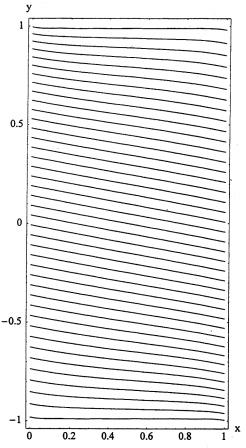
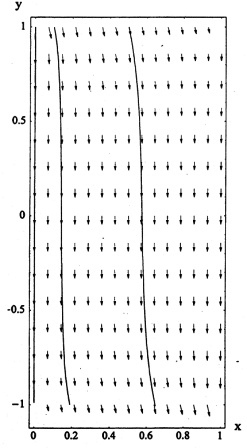
Equipotentials (left) and current density (right) in a metal plate for a Hall effect
experiment. Potentials of +1 v and -1 v are applied at the top and bottom
edges of the plate. A uniform magnetic field is into the plane. This
electrostatic potential problem provides a simple but surprisingly rich example
of a non-standard boundary-value problem. That is, the natural boundary conditions are not of Dirichlet, Neumann, or of mixed Dirichlet and Neumann
type. The resulting family of basis functions are not all orthogonal in pairs; a
special technique is therefore required for constructing a solution.
See "Electric
potential in the classical Hall effect:
An unusual boundary-value problem"
(1998).